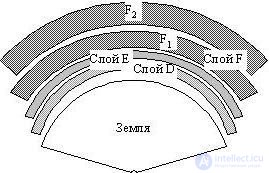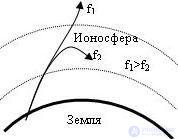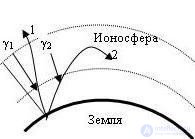Lecture
Radio waves are one of the ranges of electromagnetic waves, therefore the propagation of radio waves obeys the general laws of propagation of electromagnetic trains *** (as well as light waves). The propagation of radio waves in Earth conditions has some significant differences from the propagation of radio waves in free space. The surface layers of the Earth and near-Earth space are environments with different characteristics for the propagation of an electromagnetic field. Just as for optical waves, reflection and refraction of radio waves are possible at the interface of media with different electrical characteristics (for example, the earth - near-earth space). At the same time, the Earth’s surface itself and near-Earth space are inhomogeneous media with different electrical parameters (electrical conductivity, dielectric constant, etc.). Therefore, when electromagnetic waves propagate in inhomogeneous media, both the direction and the velocity of propagation of electromagnetic energy (refraction) can change. Additional absorption of radio wave energy is observed when they propagate in media with losses.
An essential feature of the propagation of radio waves in terrestrial conditions is the dependence of the propagation characteristics on the wavelength. The propagation of radio waves along the earth's surface depends on its terrain and physical properties. The most important electrical parameters of a soil are its electrical conductivity and dielectric constant. These characteristics determine the parameters of the reflected and refracted waves at the interface of two media. The conductivity of the soil also determines the loss of energy during wave propagation. There are no energy losses during the propagation of radio waves, if the Earth's surface can be considered an ideal conductor or an ideal dielectric. In real conditions, electromagnetic waves propagating above the earth's surface *** induce induction currents in the soil. When these currents flow in the soil, heat is generated. Ultimately, this causes irretrievable losses of a propagating electromagnetic wave. These losses increase with increasing frequency.
No less important influence on the propagation of radio waves in near-Earth space is played by the Earth's atmosphere (gaseous shell of the Earth). According to the complex of physical features, the atmosphere can be divided into three characteristic layers: the troposphere, the stratosphere and the ionosphere.
The troposphere is a lower layer of the atmosphere, located from the surface of the Earth to altitudes of the order of 10 - 20 km. The properties of the troposphere are determined by a mixture of gases (nitrogen, oxygen, etc.) and water vapor. The temperature and air pressure, as well as the water vapor content in the troposphere, decrease with altitude. Thus, the troposphere is heterogeneous in its electrical properties. In addition, the change in weather conditions leads to the formation of air currents, causing intense mixing of the layers of the troposphere.
The stratosphere - the layer of the atmosphere that lies above the troposphere, extends to altitudes of about 60 - 80 km. A sign of the transition to the troposphere is the cessation of the decrease in its temperature with height (in the upper layers of the troposphere, the temperature drops to - (50 ... 60) ° C). The density of gases in the stratosphere is significantly less than in the troposphere. The electrical properties of the troposphere are practically unchanged, and radio waves propagate in it in a straight line and almost without loss.
The ionosphere is the upper layer of the ionized atmosphere surrounding the Earth (up to heights of the order of several thousand kilometers). Under the influence of cosmic radiation and ultraviolet rays of the sun, electrons are knocked out of the gas atoms that make up the atmosphere, resulting in the formation of positive gas ions and free electrons. When a free electron encounters an ionized atom, they combine (recombine). At high altitudes, the density of the atmosphere is low, so the probability of a meeting of a free electron with a gas ion is small, and a significant part of the gas is ionized. Ionized gas has electrical conductivity and is capable of changing the characteristics of the propagation of electromagnetic fields ***. The greater the concentration of free electrons, the stronger they affect the propagation of radio waves. The degree of ionization of a gas is determined by many factors.
First, since the main cause of ionization is the radiation of the Sun, it is clear that the ionization processes occur more actively in the areas of the Earth’s atmosphere facing the Sun. Accordingly, in the daytime, in the process of ionization, a larger number of free electrons and ionized molecules appear than at night. In addition, an increase in the intensity of solar radiation during the daytime leads to the ionization of atmospheric layers located closer to the surface of the Earth, i.e. to reduce the height of ionized gases.
Secondly, at a height of hundreds of kilometers from the surface of the Earth, the gas composition of the atmosphere ceases to be uniform. At these heights, there is a separation of the gases that make up the air: heavier gases occupy mostly the lower part of this range of heights, lighter gases are able to rise to higher elevations.
The processes described above lead to the fact that the concentration of charged particles (ions and electrons), both in geographic coordinates and in height, turns out to be non-constant. Depending on the height of the ionized gas on the height, a number of extremes are observed. Layers of the atmosphere appear in which the number of charged particles turns out to be greater than at neighboring heights. Areas with increased concentration are combined into layers located at different heights. These layers have special names.
Ionized layers of the Earth’s atmosphere are conventionally shown in Figure 6.1. At heights of 60 ... 80 km from the Earth's surface, there is a layer D, existing only during the day, when the intensity of the ionizing radiation of the Sun is great. At heights of 100 ... 120 km above the Earth's surface, layer E is located. Since the concentration of free electrons depends on the time of year and day and is determined by the influence of solar radiation: during the daytime, layer E falls below, rises above at night. The areas with the highest concentration of free electrons form a layer F, located at night at altitudes of 250 ... 350 km. During the day, this layer disintegrates into two sublayers: F1 and F2, located at altitudes from 180 to 450 km from the Earth's surface.

Fig.6.1 Ionized layers of the Earth’s atmosphere
The representation of the ionosphere in the form of layers is rather arbitrary. In real conditions there are no clear boundaries between ionized and non-ionized areas of the upper atmosphere. In any place of the atmosphere, charged particles can be detected, but their concentration at different heights will be different. And the transitions from layer to layer have finite (non-zero) length. But still such a simplified picture of the ionosphere helps to understand the processes of radio wave propagation in the upper atmosphere. The presence of a "shell" of ionized gas around the Earth determines the characteristics of the propagation of electromagnetic waves. Since the electrophysical properties of the atmosphere change with a change in the time and coordinates, the conditions for the propagation of electromagnetic rings *** also change.
This is particularly true of the change in the direction of propagation of radio waves. The deviation of the direction of propagation of radio waves from the rectilinear one has the same nature as the refraction of light waves when light passes through optical media with different refractive indices.
The curvature of the direction of propagation of radio waves is due to changes in the parameters of the propagation medium (in the ionosphere this is the change in the concentration of ionized gas) and depends, among other things, on the height above the Earth's surface. The refractive indices of the ionosphere change with height in such a way that the direction of propagation of radio waves bends toward the Earth. This phenomenon is called normal refraction. Often this curvature becomes so significant that the radio waves emitted from the surface of the Earth return back to Earth.
The characteristics of the curvature of the direction of radio waves largely depend on the length of the propagated wave. The shorter the wavelength, the lower the degree of refraction of the direction of radio waves. With increasing frequency, the refraction of radio waves affects less and less, very short waves pass through the atmosphere and continue to propagate in space. The range of radio waves that can overcome the ionosphere, is used in space and satellite communications systems. Figure 6.2 shows the propagation paths of radio waves used for space communications with a frequency f1 and ground communications with a frequency f2.

Fig. 6.2 Refraction of radio waves at different wavelengths
The magnitude of the change in the direction of propagation of radio waves also depends on the angle of incidence of radio waves on the ionized layer. The smaller the angle of incidence of the radio waves on the ionized layer, the less it experiences a change in the direction of wave propagation in this layer. Figure 6.3 shows the trajectories of rays 1 with an angle of incidence on the ionizing layer equal to γ1, beam 2 with an angle of incidence on the ionizing layer equal to γ2. Beam 1 with a smaller angle of incidence receives a slight curvature of the direction of propagation, and the trajectory of beam 2 bends so much that the beam returns to the ground again.

Fig. 6.3 Refraction of radio waves at different angles of incidence
In the ionized layers of the atmosphere, the radio waves decay much more strongly than during propagation in the troposphere, and the attenuation of radio waves increases with decreasing frequency.
Thus, the propagation of radio waves depends on many factors. First of all, the conditions of propagation of electromagnetic cololes *** change with decreasing wavelength (increasing frequency of colo ***). Consider the features of the propagation of radio waves, depending on the wavelength of electromagnetic radiation.
Comments
To leave a comment
Devices for the reception and processing of radio signals, Transmission, reception and processing of signals
Terms: Devices for the reception and processing of radio signals, Transmission, reception and processing of signals